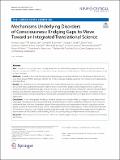| dc.contributor.author | Luppi, Andrea I. | |
| dc.contributor.author | Cain, Joshua | |
| dc.contributor.author | Spindler, Lennart R. B. | |
| dc.contributor.author | Górska, Urszula J. | |
| dc.contributor.author | Toker, Daniel | |
| dc.contributor.author | Hudson, Andrew E. | |
| dc.contributor.author | Brown, Emery N. | |
| dc.contributor.author | Diringer, Michael N. | |
| dc.contributor.author | Stevens, Robert D. | |
| dc.contributor.author | Massimini, Marcello | |
| dc.contributor.author | Monti, Martin M. | |
| dc.contributor.author | Stamatakis, Emmanuel A. | |
| dc.contributor.author | Boly, Melanie | |
| dc.date.accessioned | 2021-10-04T18:51:16Z | |
| dc.date.available | 2021-10-04T18:51:16Z | |
| dc.date.issued | 2021-07 | |
| dc.identifier.issn | 1541-6933 | |
| dc.identifier.issn | 1556-0961 | |
| dc.identifier.uri | https://hdl.handle.net/1721.1/132705 | |
| dc.description.abstract | Abstract
Aim
In order to successfully detect, classify, prognosticate, and develop targeted therapies for patients with disorders of consciousness (DOC), it is crucial to improve our mechanistic understanding of how severe brain injuries result in these disorders.
Methods
To address this need, the Curing Coma Campaign convened a Mechanisms Sub-Group of the Coma Science Work Group (CSWG), aiming to identify the most pressing knowledge gaps and the most promising approaches to bridge them.
Results
We identified a key conceptual gap in the need to differentiate the neural mechanisms of consciousness per se, from those underpinning connectedness to the environment and behavioral responsiveness. Further, we characterised three fundamental gaps in DOC research: (1) a lack of mechanistic integration between structural brain damage and abnormal brain function in DOC; (2) a lack of translational bridges between micro- and macro-scale neural phenomena; and (3) an incomplete exploration of possible synergies between data-driven and theory-driven approaches.
Conclusion
In this white paper, we discuss research priorities that would enable us to begin to close these knowledge gaps. We propose that a fundamental step towards this goal will be to combine translational, multi-scale, and multimodal data, with new biomarkers, theory-driven approaches, and computational models, to produce an integrated account of neural mechanisms in DOC. Importantly, we envision that reciprocal interaction between domains will establish a “virtuous cycle,” leading towards a critical vantage point of integrated knowledge that will enable the advancement of the scientific understanding of DOC and consequently, an improvement of clinical practice. | en_US |
| dc.publisher | Springer US | en_US |
| dc.relation.isversionof | https://doi.org/10.1007/s12028-021-01281-6 | en_US |
| dc.rights | Creative Commons Attribution | en_US |
| dc.source | Springer US | en_US |
| dc.title | Mechanisms Underlying Disorders of Consciousness: Bridging Gaps to Move Toward an Integrated Translational Science | en_US |
| dc.type | Article | en_US |
| dc.identifier.citation | Luppi, A.I., Cain, J., Spindler, L.R.B. et al. Mechanisms Underlying Disorders of Consciousness: Bridging Gaps to Move Toward an Integrated Translational Science. Neurocrit Care 35, 37–54 (2021) | en_US |
| dc.contributor.department | Massachusetts Institute of Technology. Department of Brain and Cognitive Sciences | |
| dc.relation.journal | Curing Coma Campaign | en_US |
| dc.eprint.version | Final published version | en_US |
| dc.type.uri | http://purl.org/eprint/type/JournalArticle | en_US |
| eprint.status | http://purl.org/eprint/status/PeerReviewed | en_US |
| dc.date.updated | 2021-10-03T03:08:17Z | |
| dc.language.rfc3066 | en | |
| dc.rights.holder | The Author(s) | |
| dspace.embargo.terms | N | |
| dspace.date.submission | 2021-10-03T03:08:17Z | |
| mit.journal.volume | 35 | en_US |
| mit.license | PUBLISHER_CC | |
| mit.metadata.status | Authority Work and Publication Information Needed | en_US |
